The persistent learning crisis in Kenya necessitates a teaching workforce able to deliver concepts using appropriate teaching/learning strategies (Bunyi et al, 2011). Leveraging on global knowledge, we adapted the Teaching at the Right Level approach, extensively tested by Pratham and JPAL in India, to reach children furthest behind in Kenya. To date, we have reached over 36,000 children.
The innovation applies four key components: 3-step teacher preparation approach – a 6-day teacher induction in participatory and play-based methodologies, 10-day Do-It-Yourself sessions in schools, and 3-month refresher trainings and mentor support; Use of simple assessments to identify the actual levels of children and use of evidence to create ability-based learning groups; level-based learning camps applying the participatory pedagogy (30 days total), and assessing children regularly to promote and re-group as they proceed from one level to another. Within 30 days days, 76% of learners progress by at least one competency level in literacy and numeracy. Parental engagement is sought through community conversations.
During COVID closures, combining community learning camps and low-tech innovations using SMS and radio-based learning added to the resilience of this approach. Over 4500 were children reached through community based camps, and 1660 solar-powered radios distributed.
From 11 schools in Turkana in 2018, ALP spread to 60 schools in 2019, to 119 in 2020 and to 150 by 2021 in Turkana, Bungoma and Tana River Counties. Results from 2018/19 showed that through the retooled teachers, it was possible to significantly reduce the proportion of learners without foundational skills by 60% within 30 days, informing the decision to expand. The intervention has benefitted 265 Teacher Assistants and 182 headteachers, strengthening their capacities on FLN support. Beyond direct intervention, ALP has been adopted by 9 other civil society organizations, implemented in 7 counties and benefitted over 11,000 learners, bringing the total reach to over 36,000 learners in 269 schools. Due to its impact, an extra 52 non-program public schools have recently been inducted.
Identify simple assessment tools to establish learning levels
Use the DIY process to adapt manuals and approach to the implementation context
Qualify a pool of master trainers
Induct teachers and offer continuous support in assessment, grouping, goal setting, designing level-based activities and parental engagement
Allow teachers to innovate and adapt strategies that work for them.
Collaborate!



